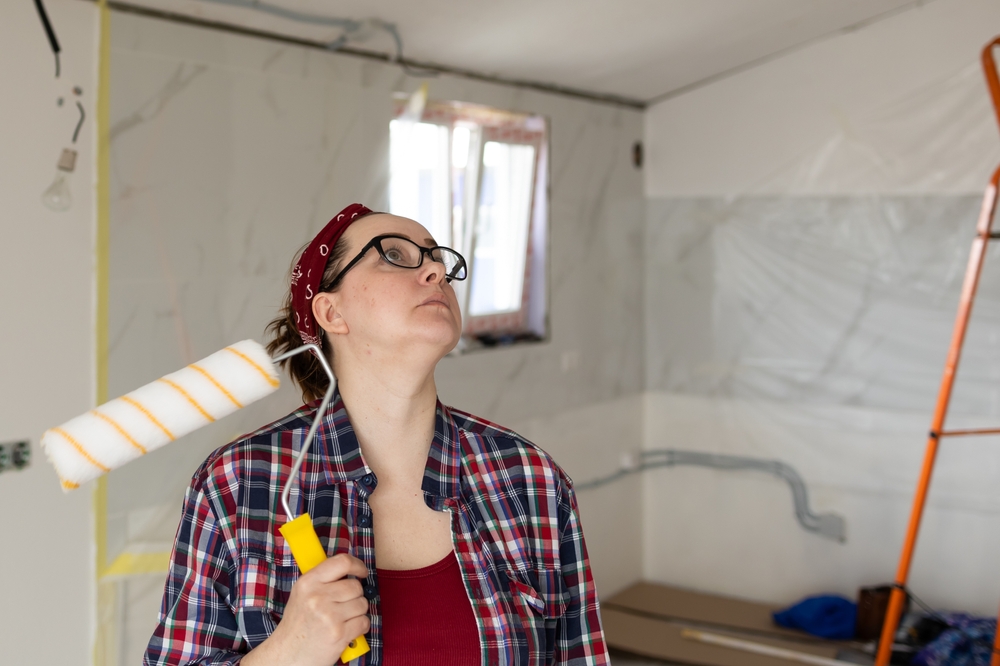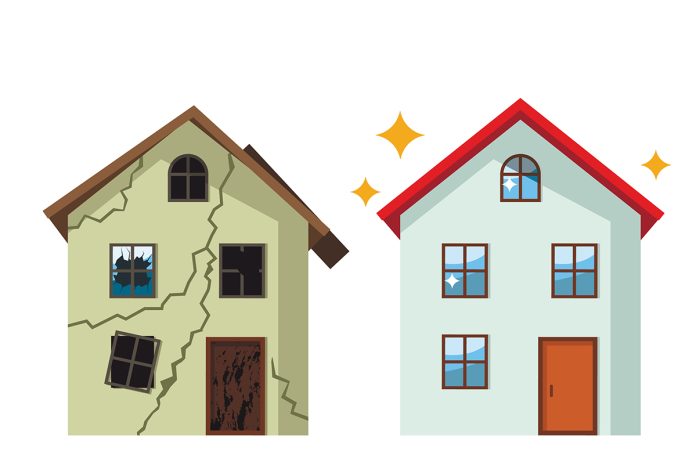Some people walk into a ‘project’ house and see limitless possibilities, while others walk in and walk right back out. This difference leads us to one of the biggest decisions you’ll face: whether to purchase a fixer-upper or a move-in ready home.
Both options have their unique advantages and challenges, and understanding these factors can help you make a more informed decision that aligns with your budget, timeline, and long-term goals. In this guide, we’ll break down the pros and cons of each option, provide tips for evaluating homes, and offer resources to help you make the right choice.

What is a Fixer-Upper?
A fixer-upper is a property that requires significant repairs or renovations before it can be fully functional or aesthetically pleasing. These homes are typically priced lower than move-in ready properties, offering potential buyers the opportunity to build equity by improving the home’s condition.
Pros of Buying a Fixer-Upper
- Lower Purchase Price:
Fixer-uppers are usually priced below market value, allowing buyers to save money upfront.
Tip: Use online real estate platforms like Zillow or Realtor.com to compare prices of fixer-uppers and move-in ready homes in your area. - Customization Potential:
Buyers have the freedom to renovate and customize the home to fit their personal tastes and lifestyle needs. - Equity Growth Opportunity:
By improving the home, buyers can potentially increase its market value significantly, leading to greater equity over time. - Less Competition:
Since many buyers prefer move-in ready homes, fixer-uppers often face less competition, which can give you an advantage in negotiations.
Cons of Buying a Fixer-Upper
- High Renovation Costs:
Renovations can quickly become expensive, especially if the home requires major structural repairs.
Tip: Use a renovation cost estimator like HomeAdvisor’s True Cost Guide to get an idea of what common home improvements will cost. - Unforeseen Issues:
Hidden problems, such as mold, faulty wiring, or plumbing issues, may arise during renovations, adding to the overall expense and timeline. - Time-Consuming:
Renovating a home takes time and effort, which may not be ideal for buyers who need to move in quickly. - Financing Challenges:
Not all lenders offer conventional mortgages for fixer-uppers. Buyers may need to explore special loan programs designed for homes in need of repair.
Best for:
- Buyers who are comfortable with managing renovation projects.
- Those who want to build equity and customize their home.
- Investors or house flippers looking to maximize returns.
Reality Check for Fixer-Uppers
It’s so easy to be inspired by home renovation shows on HGTV. They make the process look exciting, stylish, and—most importantly—quick. The entire job is usually completed in a one-hour episode! You can watch shows like Fixer Upper or Property Brothers and walk away with dreams of transforming a run-down house into a personalized dream home with just a little elbow grease and a modest budget. While those shows are great for sparking ideas, the reality of renovating a house can be vastly different.
- Timelines Are Longer than You Think
On TV, renovations seem to happen in a matter of weeks, but in real life, projects often take much longer. From securing permits to dealing with contractor schedules, supply chain delays, and unexpected structural issues, real-world timelines can stretch into several months—or even longer.
Reality Check: A kitchen renovation that takes “three weeks” can easily take three to four months in real life, especially if there are custom components or structural changes involved.
- Budgets Are Guesses
Renovation budgets can balloon due to unforeseen issues like outdated wiring, water damage, or foundation problems. Renovators on TV rarely deal with the full range of hidden costs that real-life buyers encounter.
Reality Check: According to HomeAdvisor’s True Cost Guide, major renovations frequently exceed initial estimates by 20% to 30%.
- It’s Messy and Stressful
Renovation shows often skip over the daily chaos of living through a remodel. Dust, noise, and the inconvenience of not having access to parts of your home are very real challenges. Many homeowners choose to move out during major renovations, which adds to the overall cost.
Reality Check: If you plan to live in the home while renovating, be prepared for disrupted routines.
- DIY Isn’t Always the Best Option
While DIY can be cost-effective for smaller, simpler tasks like painting or landscaping, attempting complex jobs (like plumbing or electrical work) without professional help can lead to costly mistakes and safety hazards.
Reality Check: Be honest about your skills and experience. For major tasks, hire licensed professionals.
What is a Move-in Ready Home?

A move-in ready home is a property that’s in excellent condition and requires little to no immediate repairs or renovations. These homes are ideal for buyers who want a hassle-free purchasing experience and prefer to settle in right away.
Pros of Buying a Move-in Ready Home
- Convenience:
Move-in ready homes require minimal effort, allowing buyers to move in immediately after closing. - Predictable Costs:
Since the home doesn’t require significant repairs, buyers can avoid unexpected renovation expenses. - Faster Process:
Without the need for extensive repairs or remodeling, the home-buying process can move more quickly. - Energy Efficiency and Modern Features:
Newer or recently renovated homes often come with energy-efficient appliances, updated systems, and smart home features.
Cons of Buying a Move-in Ready Home
- Higher Purchase Price:
Move-in ready homes tend to be priced higher than fixer-uppers due to their condition and convenience. - Limited Customization:
Since the home is already complete, buyers have fewer opportunities to make changes or personalize the space. - More Competition:
Move-in ready homes are highly desirable, which can lead to bidding wars and higher selling prices. - Lower Potential for Equity Growth:
With a move-in ready home, there’s less opportunity to significantly increase the home’s value unless market conditions improve.
Best for:
- Buyers who need to move in quickly or lack the time and resources for renovations.
- First-time homebuyers who may not have experience managing home improvement projects.
- Those who prioritize convenience over potential savings.
Key Factors to Consider When Choosing
Before deciding whether a fixer-upper or move-in ready home is right for you, consider the following factors:
- Budget
Determine your total budget, including not just the purchase price but also renovation costs, closing costs, and any unexpected expenses.
Tip: Use a mortgage calculator like Bankrate’s Mortgage Calculator to understand your monthly payments for different price points. - Timeline
How soon do you need to move? If you’re on a tight timeline, a move-in ready home might be the better choice. If you have flexibility, a fixer-upper could be worth the wait. - DIY Skills and Experience
Are you handy and willing to take on some of the work yourself? If so, you can save on labor costs with a fixer-upper. Otherwise, hiring contractors will add to the expense. - Neighborhood and Location
Sometimes, a fixer-upper in a desirable neighborhood can offer better long-term value than a move-in ready home in a less desirable area.
Tip: Use tools like NeighborhoodScout to research neighborhoods, crime rates, and school districts. - Loan Options
Certain loan programs, such as the FHA 203(k) loan, are specifically designed for buyers purchasing fixer-uppers. For move-in ready homes, conventional loans or VA loans may be better suited.
Tip: Learn more about FHA 203(k) loans at HUD.gov.
Hints of What to Expect
When browsing home listings, certain words and phrases can hint at whether a property is a fixer-upper or move-in ready. Fixer-uppers often come with descriptions like “needs TLC,” “handyman special,” or “sold as-is”—all of which suggest that significant repairs or updates may be necessary. Listings that mention “great potential” or “bring your imagination” imply that while the home might need a lot of work, it could be transformed into something valuable. Another common phrase for these types of homes is “original condition,” which usually means the property hasn’t been updated in decades and requires a full remodel.
On the other hand, move-in ready homes often come with words like “turnkey,” “newly renovated,” or “fully remodeled.” These phrases signal that the home is in excellent condition and requires little to no immediate work. Descriptions like “immaculate” or “well-maintained” suggest that the previous owners took good care of the property, making it ready for new occupants without the need for major updates. Some listings also highlight specific modern improvements by using terms like “upgraded features” or “modern amenities,” indicating high-quality finishes and conveniences.
Understanding these subtle cues in home listings can help you quickly determine which properties match your needs and preferences. If you’re looking for a project, keep an eye out for fixer-upper keywords that hint at potential equity growth through renovations. If you prefer to move in without the hassle of remodeling, prioritize homes described as turnkey or newly renovated. Reading between the lines can save you time during your search.
Keep in Mind…
Choosing between a fixer-upper and a move-in ready home ultimately comes down to your budget, timeline, and personal preferences. If you’re looking for a project, want to build equity, and don’t mind living through renovations, a fixer-upper might be the right choice. On the other hand, if you prefer convenience, predictability, and moving in quickly, a move-in ready home could be a better fit.
Whatever option you choose, thorough research, careful planning, and understanding your needs will help you find the home that is perfect for you.


